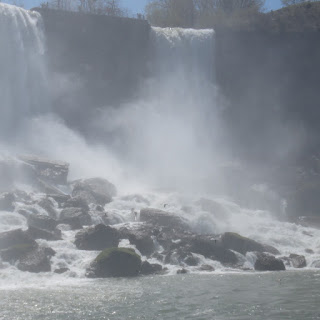Day 21: Niagara Falls:
Reluctantly leaving our luxury accommodation in Pennsylvania, we drove towards the USA/Canada border at Niagara Falls.
The drive was through more beautiful countryside. We had a couple of stops, the first being at the Harley Davidson factory. Roger delighted in sitting on a Harley, but I just enjoyed a cup of coffee.
The second stop was at the Corning Glass factory and museum which was very interesting. I would have like to have come away with some beautiful glass items or even a set of casseroles but lack of space, weight and thrift made me choose otherwise.
We were soon at the border, where passport clearance was uneventful, owing to the resolution of considerable passport and visa problems. Both will be the subject of another blog which will be titled something like ‘Mim’s travel dramas: this time USA visa and recovery of lost passport’!!!
Upon booking into our hotel, we found that Trafalgar had again spoilt us with wonderful accommodation. We were in a 14th floor room of the Hilton, looking right over the Niagara Falls!
 Focus of this photo is not to be the half-naked man, but the view of Niagara Falls in the background. (The ugly rooftop needs to be blotted out in your imagination.)
Focus of this photo is not to be the half-naked man, but the view of Niagara Falls in the background. (The ugly rooftop needs to be blotted out in your imagination.)
As the evening proceeded, the casino across the road put on a spectacular light show, changing colour every minute or so. The American part of the falls was also lit up with coloured lights. (Maybe the larger ‘Horseshoe Falls’ were as well, but from our room we didn’t have a direct view of them.)
Breakfast was on the 33rd floor, so more wonderful views of the falls while we munched on our breakfast. Here we had a great view of the massive spray that comes from the Horseshoe falls. The height of it make it look like a cloud of steam rising high into the air.
The main event of the day was a twenty-minute boat trip right to the bottom of the falls! It was a beautiful sunny day, not a cloud in the sky nor a puff of wind. From the bank of the Niagara River we had watched little boats doing the trip up and down, carrying boatloads of tourists. All had plastic ponchos, red for one tour company and blue for the other. It was a rather poignant detail that for each company, the children had a different coloured poncho. For example, ours were red, but the children on our boat had green. I can only surmise that this would be incase of a tragic boat incident. The green ponchos would identify the children who, I imagine, they would attempt to rescue first.
It was so exciting to sail first past the American and Bridal Falls and then up to the massive Horseshoe Falls. The American and Bridal are the higher, much narrower of the three falls. In some way, I think they are the more picturesque, because of rock mounds at their base. Apparently, these rocks are the result of several landslides during the last hundred years. In the 1950’s, Ben told us, the US government dammed up the river, completely stopping the flow of water over these falls. All the water flowing down the Niagara River was then directed over the Horseshoe Falls while the rock fall at the base of the American Falls was concreted up, thus preventing further erosion. It has remained stable ever since.
From there it was up to the Horseshoe Falls, the ones most frequently pictured. The volume of water flowing over them is simply astounding! Ben said that he has never seen them so full, and he has seen them every three weeks for the last seventeen years! We had been subjected to some spray from the American and Bridal Falls, but nothing like that coming from the Horseshoe Falls. There was absolutely no hope of photographing it as we came right up to it. The force of the spray was inclined to knock us off our feet and it was as much as we could do to stand up and hang onto our billowing ponchos which, of course, proved to be extremely necessary.
Too soon it was over and we headed back to dry land, exhilarated by this most unusual and momentous experience.
Late afternoon we set out for a small historic town around half an hour’s drive from Niagara. Named ‘Niagara on the Lake’ it is a beautiful settlement on the shores of Lake Ontario. Close to the town we passed what must surely be the smallest church in the world!
After the War of Independence, many British loyalists chose to move from America, across the border to the provinces that would later become Canada. This was one such settlement. Burned down by the British in the war of 1812-1814, it was subsequently rebuilt and is today a beautifully presented, picturesque historic town, with tourism high on its agenda. It also thrives on wineries and fruit – mainly peaches. A local man we met told us that he has lived there all his life and it is a wonderful place to live.
I am finishing this post with some images of the wonderful spring flowers we have been treated to.























No comments:
Post a Comment